Laura, who used to manage a trendy cocktail pub, changed her mind after she met a friend who had embraced Islam
Uplifting the Female without dumping her status
Among the most intensely discussed issues of today is the upliftment of women. The issue has attracted attention from all walks of life, creating both controversies and emotional response.
Rabia Basri : The jewel from Basra
I am poor orphan and a slave. Now my hand too is broken. But I do not mind these things if Thou be pleased with me. But make it manifest to me that you are pleased with me
Unveiling the Veil
“Neither purdah nor education, be it new or old,
Man alone is the sentinel of female’s womanhood
Of the people who did not understand this living truth
The sun has set very soon.”
– Allama Iqbal
Although Eid has lost its previous glory due to the commercialization, it has not affected the sale of purdah. While there is no check on the trends in fashion, the demand for purdah has not decreased. Unlike other costumes, it is more easier to wear in today’s busy life. It is also worn on top of other dresses as well.
A Purdah Wallpaper Iqbalian philosophy>>
The diversity of designs adds to the purdah demand. The different embroidery designs are special to purdah. The loose dress, which comes in one piece of cloth, adds to the flexibility while traveling, especially for working women.
Initial demand favored black, but that has changed over the course of time. The youngsters favor bright colors. There are purdahs for age groups ranging from 5 years to 100 years. The old people prefer burqa in two-piece.
The demand kicked off after purdah was made uniform in colleges and madrassas. Purdah retailers claim that there will be no Muslim house in Kerala without purdah.
Tailoring techniques like cutwork, pearl work, lace work, embroidery adds to the beauty of the purdah, along with the cost. The sales are at its peak in Calicut, Malappuram and Kannur. The Wayanad district is only catching up in the demand. In the south, purdah is popular in Alleppey and Kollam districts. Purdah is exported from Kerala to Tamil Nadu, Karnataka and gulf countries as well.
‘Purdah is safety, not ornamentation’, admits one retailer. While the local brand names perform well in the markets, the holiday seasons like Eid call for foreign brand names. The youths prefer red colors while also available are navy blue, coffee brown, grape color etc. Also on the shelves are Arabian, Iranian and Korean Purdah.
Like any other consumer product, modern purdahs are tailored embracing the taste of the consumers. The high price of purdah is due to the imported material, which comprises sixty percent of the cost.
Special thanks to my friend for bringing this topic to my attention. Based on the report published by Chandrika Daily. Edited by Jaihoon
Purdah in MeraWatan : Why?
A costume, which has its roots in sands of Arabia, has transformed itself to become an integral part of the land of the paddy fields. Surprisingly, it has RE-emerged, not in the dark corners of the secluded house, but in the public colleges and universities, in flooded markets and public functions and at government offices and hospitals.
It is no more the symbol of seclusion and aesthetics. And the irony is that the Arabian-born dress is presently exported back to Arab countries from Khairullah. While the former was a cultural export, the latter becomes a case of economic good.
Indian Shalwar, Malaysian Scarf, Arabian Jewellery & a Wedding
Although nikah is the obligatory part and the reception a Sunnah (Prophetic practice, sallallahu alaihi wa sallam), the amount of time and effort (and money) invested is far from balanced.
The preparations start almost a month before the event. The male members travel to all the four directions for inviting near and far (and farthest) relatives and in-laws spread over generations. Wedding cards are printed and given to the guests on their visit. The list is meticulously prepared, with careful consultations with elders so that no one is missed. The actual turnout maybe less or even three times more!
The shed is made of long bamboo sticks and covered by sheets, with strong protection from the monsoon rain. This takes almost a week to complete.
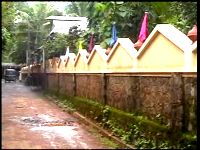


The house is decorated with artistic creations, in this case,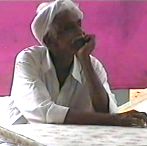 colorful flags were tied on the fence of the house. Wishes from family members and verses from the Holy Book are written on charts and pasted on walls of the interior.
colorful flags were tied on the fence of the house. Wishes from family members and verses from the Holy Book are written on charts and pasted on walls of the interior.
Every member of the household, young and old, plays an active role in the preparations for the joyful event. The old ones may sometimes resort to silent supervision, with respect to their wisdom and experience.
 The previous night of the wedding also witnesses a festive mood with neighbors and immediate family members pouring to share the joy and anxiety for the next day. Some guests who are unable to attend the wedding day, also make their visit on the previous night.
The previous night of the wedding also witnesses a festive mood with neighbors and immediate family members pouring to share the joy and anxiety for the next day. Some guests who are unable to attend the wedding day, also make their visit on the previous night.
The crowd remains up to late in the night and gives a helping hand to the household in whatever capacity they can. Chairs and tables are laid in lanes and all the ingredients required for next day’s feast is made available.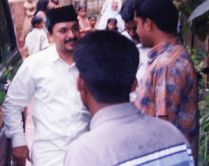
The wedding is also a good opportunity to renew existing relationships within the community and establish new ties. In some cases, it becomes a lifetime opportunity to meet far off relatives, who one may not meet later in their life.
The guests start to arrive from around 10 in the morning and continues to 2 o 3 in the afternoon.
Depending on the prevailing custom in certain areas, sometimes a small group of men come from the bride’s house to call upon the groom. He leaves with them, along with the ladies of his household normally led by his sister to bring the bride home.
Before leaving, a dua session takes place, usually by a well-known figure. In this case, it was the Sayyed Sadiq Ali Shihab Thangal, state president of Youth League (a wing of Indian Union Muslim League).
The boy is dressed in bright cream-colored sherwani suit with golden embroidery. Although a costume belonging to the North of India, this has becoming very popular in the south also. Western outfits like the Suit and tie has taken a back seat in the recent times.
India, this has becoming very popular in the south also. Western outfits like the Suit and tie has taken a back seat in the recent times.
It is the men who get to display their prowess in the nikah. But in a wedding it is the ladies who reign supreme. If nikah is all about the singular white fabric and handshakes, then wedding is all about multi-colored costumes designed weeks before the event; jasmine flowers are ordered in bulk and hands are painted red in
henna… celebrations go to the extreme end
of the permitted limits! A day when culture shows off itself over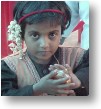
formal religion.
The boy reaches the girl’s house and is seated in middle of the crowd for everyone to see. A battalion of uncles greet him while the womenfolk crowds the verandah of the house to have a glimpse of the groom.
The sister-in-law (groom’s sister) enters into the house and starts to beautify the bride with cosmetic touches.
The bride is finally brought to sit beside the groom and camera go wild with flash lights. The bride’s parents and grandparents also join the shoot. The bride is dressed in a three-piece Indian shalwar khameez, in a mix of
parents and grandparents also join the shoot. The bride is dressed in a three-piece Indian shalwar khameez, in a mix of
maroon and golden color with plenty of embroidery, scarf modeled after a
Malaysian design and jewellery of Arabian style . Flowers are also attached.
(Globalization finally completing its reign!)
Thereafter the bride steps into the car which is decorated with flowers and names of the couple. Her feelings of shyness, fear and sadness result in tears which is natural of any typical bride.
The couple reaches the boy’s house accompanied by a huge crowd and they are greeted by a surprise firework show, smartly planned by the groom’s cousins. Everyone is struck and wonders what caused the explosive sound.
The guests are seated and a light entertainment show is organized. Small children play the traditional oppana dance which is typical for weddings only. In the dance, they greet the bride and pray to Almighty for the couple’s happiness.

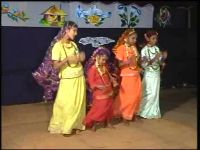
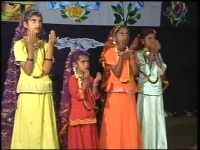
She is welcomed home by the mother-in law and in she steps with the right-foot (following the practice of Prophet sallallahu alaihi wa sallam). The latter puts for her a gold bangle, for symbolic reasons only.
The guests continue to remain in the home- everyone looking for a chance to converse with the bride and relatives introducing one another.
By almost 10pm, the guests disperse. The feast comes to an end.

